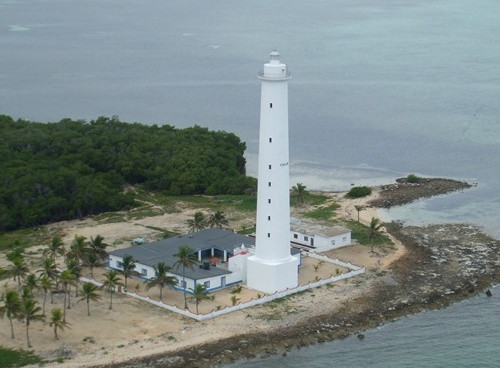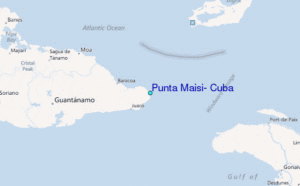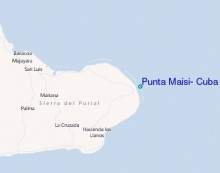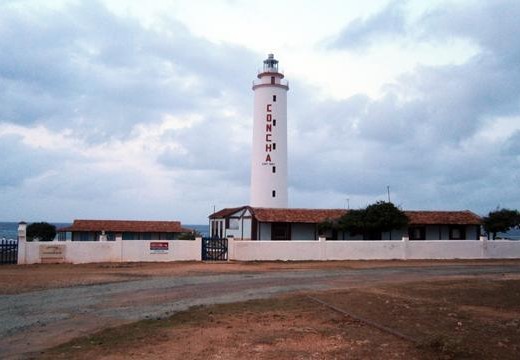 EL DESCONOCIDO “FARO DE LA PUNTA DE MAISI” Y OTROS FAROS CUBANOS.
EL DESCONOCIDO “FARO DE LA PUNTA DE MAISI” Y OTROS FAROS CUBANOS.
El Faro de Punta de Maisí, como le llaman, se encuentra situado en el extremo más oriental de Cuba, muy cerca de Baracoa, en la provincia de Guantánamo. Autorizada la construcción, fue autorizada en el año 1856 por la reina de España, y los trabajos fueron dirigidos por el Ingeniero Don Marianao Moreno.
La instalación demoró cinco años en concluir y el 16 de noviembre de 1862, hace 147 años, comenzó su actividad con el nombre oficial de Faro de Concha, apelativo adoptado en honor al militar español José Gutiérrez de la Concha (1809-1895), quien fue gobernador de la isla y Capitán General de Cuba.
A poco más de 1.000 kilómetros al oriente de La Habana, frente al Faro se encuentra el Paso de los Vientos –bravo estrecho, difícil de navegar y muy transitado–; del otro lado de este estrecho marino, y Haití a unos 80 km de distancia.
Con un alcance de 27 millas náuticas Su luz es blanca con un alcance de 32,8 km y una potencia de 3,790 bujías, posee ocultaciones en grupo de tres, alternando con ocultación de 20 segundos.
Está construido de piedras extraídas de la costa de la propia región, en una terraza inferior de un área caracterizada por ser dueña de enormes terrazas marinas en forma de herradura que van desde la Punta de Maisí hasta la Bahía de Baracoa.
Al lugar se llega a través de dos accesos un tanto peligrosos por los vericuetos dada las condiciones complicadas del relieve. Uno es a partir de Playitas de Cajobabo bordeando la costa sur hasta el poblado de La Máquina, el otro desde la ciudad de Baracoa hacia el este bordeando la costa hasta la Boca del Yumurí y descendiendo hasta la Maquina
Se trata de un sitio especial, pues los habitantes de la zona tienen el preciado privilegio de ser los primeros en divisar el sol en Cuba. En días de cielo despejado es posible ver las montañas haitianas desde la mole marina que orienta a los navegantes.
La emblemática torre es considerada, además, símbolo de fortaleza e irreductibilidad.
De tales atributos dio muestras por preservarse, imbatible, ante el huracán Mathew que azotó el extremo oriental del país, en octubre de 2016, uno de los más poderosos de la última década.
De la embestida de Matthew en la zona, rachas entre 240 y 280 kilómetros, el área de costa que se ve frente al faro era diente de perro puro, nadie podía pasar por ahí, sin embargo, el arrecife desapareció. Se apreciaba una enorme playa de arena muy blanca traída hasta allí por las fuertes olas. Las ráfagas eran tan violentas que daba la impresión que el faro se movía según relataron, entonces, especialistas y trabajadores.
En Cuba se instaló el primer faro a principios del siglo XIX, a la entrada de la bahía de La Habana, una farola de gas obtenido del chapapote, pero esta no cumplió con cabalidad el objetivo y se sustituyó por una de aceite en 1824.
Tras un análisis completo de las costas de la isla en 1843 se decidió construir otros, para orientar la navegación completa alrededor del archipiélago. Durante los años 1859 y 1860 continuaron incrementándose el número de los faros cubanos, suceso que transcurrió a lo largo del siglo diecinueve.
Destacan los principales faros ubicados en el cayo Paredón Grande, en el puerto de Isabela de Sagua, en el cabo de San Antonio, en el puerto de Santiago de Cuba, en la punta Los Colorados, en el golfo de Batabanó, en Punta Lucrecia y en la Punta de Maisí entre otros.
 THE UNKNOWN “FARO DE LA PUNTA DE MAISI”. OTHER CUBAN LIGHTHOUSES.
THE UNKNOWN “FARO DE LA PUNTA DE MAISI”. OTHER CUBAN LIGHTHOUSES.
The Punta de Maisí Lighthouse, as they call it, is located at the easternmost tip of Cuba, very close to Baracoa, in the province of Guantanamo. Authorized the construction, it was authorized in 1856 by the Queen of Spain, and the works were directed by the Engineer Don Marianao Moreno.
The installation took five years to complete and on November 16, 1862, 147 years ago, it began its activity with the official name of Faro de Concha, an appellative adopted in honor of the Spanish military José Gutiérrez de la Concha (1809-1895), who He was governor of the island and Captain-General of Cuba.
A little over 1,000 kilometers east of Havana, in front of the Lighthouse, is the Paso de Los Vientos – narrow, difficult to navigate and busy traffic; on the other side of this sea strait, and Haiti about 80 km away.
With a range of 27 nautical miles, Its light is white with a range of 32.8 km and a power of 3,790 spark plugs, it has concealments in a group of three, alternating with concealment of 20 seconds.
It is built of stones extracted from the coast of the region itself, on a lower terrace of an area characterized by owning huge horseshoe-shaped sea terraces that range from Punta de Maisí to Baracoa Bay.
The place is reached through two somewhat dangerous accesses by the vericuetos given the complicated conditions of the relief. One is from Playitas de Cajobabo along the southern coast to the town of La Maquina, the other from the city of Baracoa to the east along the coast to Boca del Yumurí and descending to La Maquina
It is a special place since the inhabitants of the area have the precious privilege of being the first to see the sun in Cuba. On days of clear skies, it is possible to see the Haitian mountains from the marine mass that guides sailors.
The emblematic tower is also considered a symbol of strength and irreducibility.
Of these attributes, he showed signs to be preserved, unbeatable, in the face of Hurricane Mathew that hit the eastern end of the country, in October 2016, one of the most powerful in the last decade.
From the onslaught of Matthew in the area, gusts between 240 and 280 kilometers, the coast area that is seen in front of the lighthouse were pure dog tooth, no one could pass by, however, the reef disappeared. There was a huge beach of very white sand brought there by strong waves. The gusts were so violent that it seemed that the lighthouse was moving as they were told, then, by specialists and workers.
In Cuba, the first lighthouse was installed at the beginning of the 19th century, at the entrance of the bay of Havana, a gas lamppost obtained from chapapote, but it did not fully meet the objective and was replaced by an oil one in 1824.
After a complete analysis of the coasts of the island in 1843, it was decided to build others, to guide complete navigation around the archipelago. During the years 1859 and 1860, the number of Cuban lighthouses continued to increase, an event that took place throughout the nineteenth century.
The main lighthouses located in the Paredón Grande key, in the port of Isabela de Sagua, in the cape of San Antonio, in the port of Santiago de Cuba, in the tip of Los Colorados, in the gulf of Batabanó, in Punta Lucrecia and in Punta de Maisí among others.
Agencies/ RHC/ Guadalupe Yaujar/ Internet Photos/ Arnoldo Varona/ www.TheCubanHistory.com
THE CUBAN HISTORY, HOLLYWOOD.










